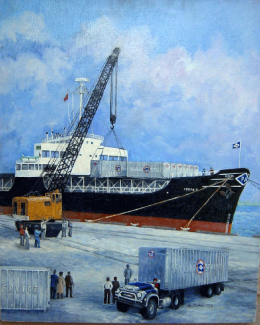
The Container Revolution
© Judith-Ann Saks
oil on canvas
Larger Image
| 10" x 13" Giclée | $89 | ||
| 12" x 16" Giclée | $175 | ||
| 15" x 20" Giclée | $299 |
The Container Revolution
In May of 1956, a strange looking ship docked at the Port of Houston, its first port of call on its initial trip. It was a T-2 tanker with platforms built over its decks on which rested fifty-eight large boxes resembling the cargo-carrying portion of a freight truck. These boxes were indeed just that---designed to be fastened to the trailer of a truck-trailer combination thereby making a freight truck. This first container ship was an experiment by Pan Atlantic Shipping Lines, later becoming Sea Land Service, Inc., to determine if it was practical to provide a service by sea and land by loading a container at the point of origin and shipping it unopened to its final destination. The containers were loaded on and off the ship by a crane which transferred the container to and from the ship to a truck-tractor semitrailer combination. Much doubt was expressed at its possibility of success and only a handful of persons witnessed the IDEAL X's arrival at Houston. But the idea turned out to be very practical and has revolutionized the shipping industry. At the time of the painting, the Port had forty-five shipping lines providing some type of container service.
Especially designed ships now carry over seven hundred containers each to a Ship Channel dock. Now, the Barbours Cut Terminal handles much larger container ships than can navigate the Ship Channel. It has special cranes and large storage and marshalling facilities for containers. At the time of the paintings, Sea-Land Services, Inc., which pioneered the use of containers, had two ships per week calling at the Port of Houston providing container service to one hundred thirty-five ports around the world.
William J. Haralson, Terminal Marine Manager of Sea Land Services, Inc., was frequently interviewed and furnished much information for the painting. William R. Goins, Southwestern Sales Manager of American Division Sea-Land Service, and Bernie Czachowski, the first Houston Sea-Land Terminal Manager and now, at its home office, were also very helpful.
Jim Bradley, at the Port of Houston, was exceptionally helpful to the artist and went to considerable trouble in seeing that equipment was properly and accurately portrayed. L. C. Butler, Vice President of New Terminal Warehouse Corp., also aided the artist. James M. Davis, too, deserves special thanks.
It would seem that information about the truck that worked the docks would have been easy to find. However, from information originally obtained, the truck could not be identified and none were now at the Port. After considerable search, a Port employee recalled that it was purchased from G.M.C. in 1956. Photographs of 1956 trucks were requested by G.M.C. representative, Marshall Johnson, and were promptly sent to the artist. However, these were pictures of standard trucks and truck-trailers and, while helpful, did not seem to fit the meager description sufficiently to identify the truck. D. R. Runkle, John Brice, and others of the local agency, Superior Truck Co., went over the matter carefully and discussions led to Bob Evans of the Parts Department. Mr. Evans said he worked twenty years before at the Port of Houston, remembered the truck clearly, and solved the mystery.
It was a special truck with no cab or license plates (it worked only on Port property shifting equipment and cargo) and the trailer had a "Texas" wheel setting. His parts book did not contain a picture of the truck, but did contain pictures of each of the body parts. Mr. Evans showed the artist the relationship of how the parts were put together. The artist assembled them as he had directed into the front of the truck and brought the painting back to him for inspection and criticism. Thus, the correct truck, even to the proper color of each part, finally was put on the painting. Below is a reduced reproduction of the parts catalogue page.
Because it was only twenty years or so earlier, the artist thought that the research required on this painting would not be as complicated as the previous paintings. But it didn't turn out that way. It was close enough in time that many persons remembered the event and the equipment, but not all remembered it alike. Recollections of placement and color of insignia, numbers and other matters were conflicting. It required extensive checking and cross checking to get this painting to the point that the artist felt was historically correct.
From the small beginning of fifty-eight containers on a platform built above the tanks of a T-2 tanker as shown in this painting, container service has become one of the most popular methods of shipping in the world.
This painting was published in the Argus, a magazine published in Turkey, in honor of the 50th anniversary of containerization.
